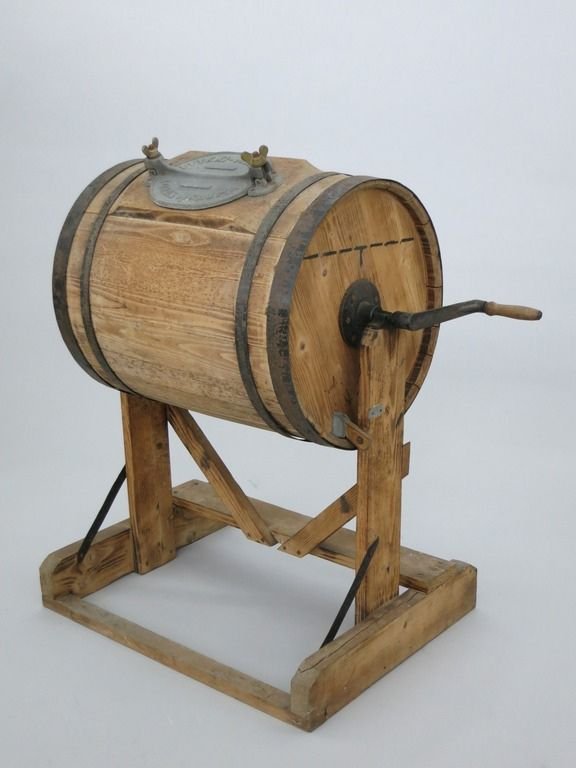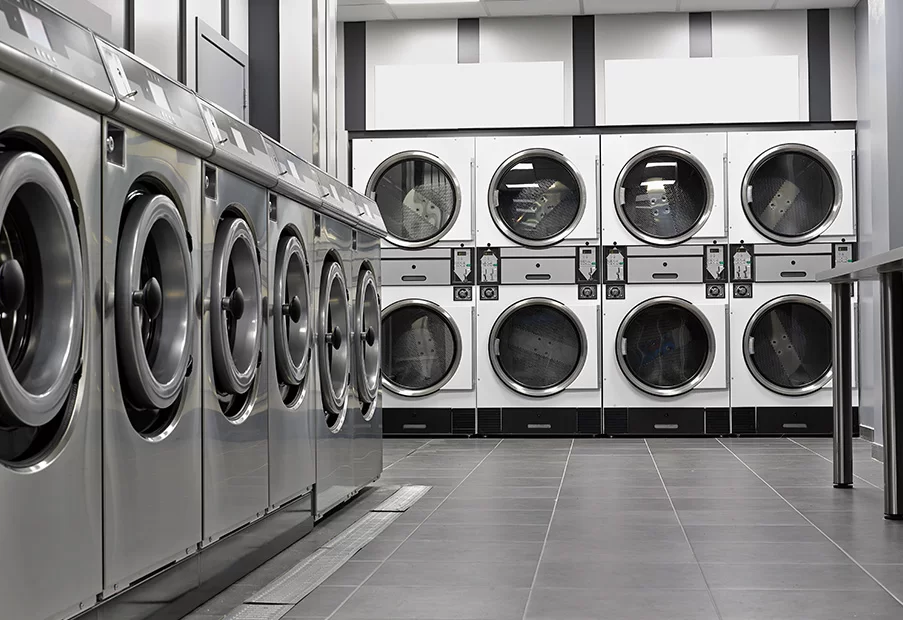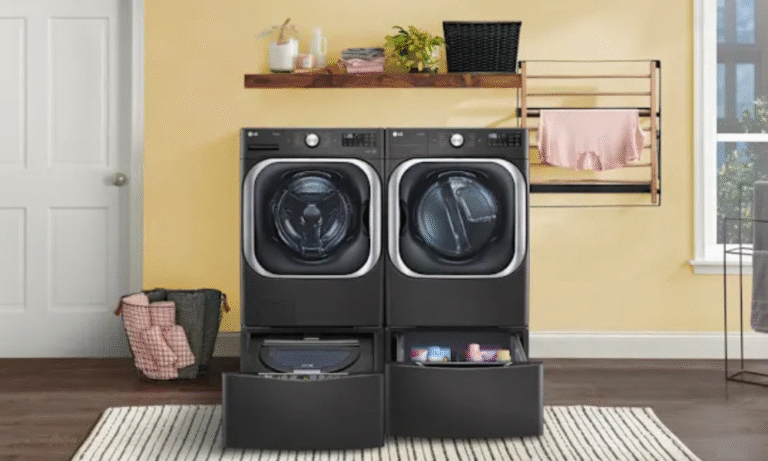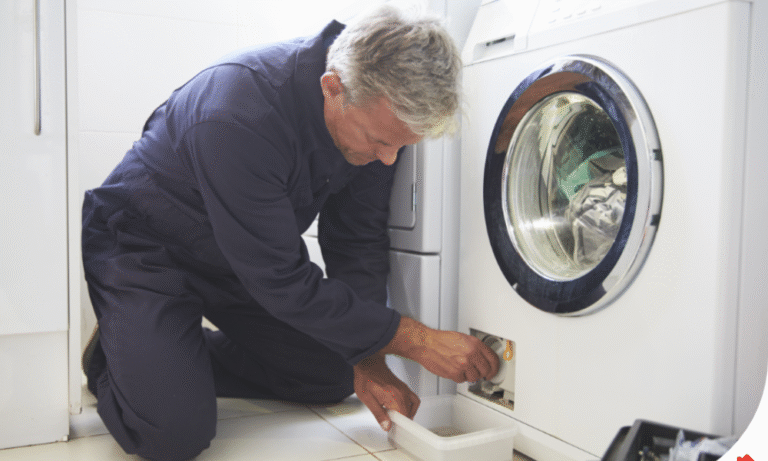Estimated reading time: 16 minutes
Last updated on August 21st, 2025 at 03:43 am
Throughout history, the washing machine has experienced a remarkable metamorphosis that has changed how we clean our clothing. Laundry care has undergone a revolution because to developments in washing machine technology, which have taken it from antiquated manual processes to modern equipment.
Its intriguing history development is explored in this essay, from its primitive infancy to the cutting-edge devices we rely on today. We may appreciate the remarkable creativity and invention that have formed this crucial home equipment by looking back at the evolution of the machine over time.
Early Origins of Washing Machines

Photo Credit: wikipedia
Laundry chores have become significantly easier as a result of the development of washing machines. These appliances have advanced significantly in terms of use and convenience from the basic scrub board to the contemporary automated washing machines. The first mechanical devices and ground-breaking improvements in manual washing machines will all be covered in this article’s discussion of the history of washing machines.
The invention of the First Mechanical Washing Devices
When people had to wash their garments by hand in the past, we can trace the history of washing machines to that period. However, the Industrial Revolution saw the introduction of the first mechanical washing machines, which transformed laundry procedures.
The Scrub Board and Hand Cranked Washing Machines
The first mechanical washing machines were straightforward yet efficient. The scrubboard, often called a washboard, was one such innovation. It was made out of a flat surface with ridges or grooves that were used to brush garments on to get rid of stains and grime. For manual washing, the scrub board was often used in homes and laundries.
The hand-cranked washing machine was an important development at this period. These devices had a tub-like design where clothing, water, and soap were put. The garments would be stirred up throughout the cleaning process by rotating a hand crank. Hand-cranked machines were a significant development in the automation of laundry while being labor-intensive and physically taxing.
Use of Early Steam-Powered Machines and Water Power
Water power developed as a crucial source of energy for many equipments, including washing machines, as the Industrial Revolution went on. Water-powered washing machines generated the necessary force for washing clothing using waterwheels or turbines. The physical effort required to clean garments was lessened by these machines, which also offered better efficiency.
Steam power was a game-changer for machines at the beginning of the 19th century. The introduction of steam-powered washing machines increased the automation of laundry. These devices automated the washing process and generated electricity using steam engines, making it easier and more practical to clean garments.
Pioneering Innovations in Manual Washing Machines
While mechanical washing machines were a great advancement, manual washing machines also underwent further developments that simplified and improved laundry duties.
Introduction of the Roller Washing Machine
The invention of the roller washing machine was one innovative development for manual machines. Clothes were passed via a pair of rollers on these machines. The rotating rollers would squeeze and agitate the clothing while they removed stains and grime. The roller washing machine is a popular option for homes and laundries since it considerably decreased the time and effort needed for manual washing.
The Washboard and Improved Mechanical Devices
The washboard and the roller washing machine both remained popular at this time. The washboard’s design was improved, integrating elements like grooves and metal components for more effective washing. These developments reduced the time and increased the efficiency of manual washing.
Other mechanical devices, such as the mangle or wringer, were invented at the same time as the washboard. Two rollers made up the mangle, which squeaked water from damp clothing to hasten the drying process. These improvements increased the adaptability and productivity of hand washing machines.
The Industrial Revolution and the Rise of Automated Washing Machines

Photo Credit: coronetequipment
Mechanical Advances in the 19th Century
Significant mechanical developments made throughout the Industrial Revolution set the stage for the development of automated washing machines.
The Drum Washing Machine’s Introduction
The drum washing machine was one of the major innovations of the Industrial Revolution. Midway through the 19th century, engineers started developing these machines using revolving drums or cylinders. These early models were primarily hand-powered and labor-intensive to use. In contrast to conventional manual methods, the use of a spinning drum allowed for a more effective and efficient washing procedure.
Electric Motors and Early Electric Washing Machines
Another significant development came with the addition of electric motors to washing machines as the 19th century went on. By eliminating the need for physical work, electric motors have improved the convenience of the laundry process. With the advent of electric machines, consumers could just load their clothing, add detergent, and let the machine do the work. This eliminated the need for any physical effort to run the machine.
The Birth of Modern Washing Machines
The birth of modern washing machines brought further advancements and options for consumers.
Top-Load vs Front-Load Machines
Front-load and top-load washing machines are the two primary types of washing machine designs that emerged in the 20th century. Front-load machines, which have horizontally oriented drums, are becoming more and more common because of their effectiveness and water-saving qualities. To clean clothing, these machines normally tumble the garments. On the other hand, some customers continued to prefer top-load machines, where the drum is vertically oriented, because to their usability and ergonomic benefits.
The Automatic Washing Machine’s Introduction
A notable invention that further altered laundry procedures was the automated washing machine. Users could choose from a variety of wash cycles when automatic washing machines were invented, and the machine would alter the water temperature, wash duration, and other parameters accordingly. Due to the automation, consumers no longer had to check on and manually adjust the washing machine, making the procedure even more comfortable and effective.
Technological Advancements in Washing Machines

Photo Credit: clootrack
The Emergence of High-Efficiency Washing Machines
Energy Efficiency and Water Conservation Features
The creation of high-efficiency washing machines that promote water and energy saving has received a lot of attention recently. To accomplish these objectives, manufacturers have introduced cutting-edge technology.
In order to save energy, modern washing machines frequently include better insulation, enhanced water flow, and recirculation systems. To make sure that just the appropriate quantity of water is used for each cycle, they employ sensors to assess the load size and change the water levels accordingly.
Advances in Sensor Technology and Load-Sensing Functions
The efficiency and convenience of washing machines have substantially benefited from the developments in sensor technology. The machine’s load-sensing features let it to determine the volume and weight of the laundry and automatically modify the wash cycle parameters.
This guarantees the best cleaning performance while utilizing the fewest resources possible. Additionally, sensors can identify elements like detergent concentrations, fabric kinds, and water temperature, allowing the machine to adjust and offer unique washing routines for various stains and textiles.
Connectivity and smart features in washing machines
Lot Integration and Remote Control Capabilities
With the use of smart technologies, washing machines are now a component of the Internet of Things (IoT). Connectivity and remote control are made possible via IoT integration. Even when users are away from home, they can now manage their machines via smartphone applications or voice assistants. This makes it simple to monitor and control laundry operations, including beginning or stopping cycles, changing settings, and getting alerts when a cycle is finished or maintenance is needed.
App-Based Monitoring and Customized Washing Programs
Manufacturers have created specialized mobile applications that offer extra features and functions in response to the introduction of smart washing machines. Users may access a broad variety of specialized washing programs for particular garment kinds or stains, track the progress of their laundry cycles, and get notifications and recommendations. By employing the best settings for each fabric, these personalized washing routines guarantee optimum cleaning results while increasing the lifespan of clothing.
Environmental Considerations and Sustainable Washing

Photo Credit: ariel
Sustainable washing techniques have received more attention in recent years as environmental awareness of washing machines’ effects on the environment has grown. Both producers and customers are thinking about how to reduce the environmental impact of laundry. The followings are some significant environmental factors and sustainable washing techniques:
Energy Efficiency
When evaluating the environmental effect of washing machines, energy consumption is an important aspect to take into account. Choosing energy-efficient versions can assist in lowering the amount of power used for washing. A high energy efficiency rating is something to look for in washing machines, such as those with the Energy Star or other equivalent certifications. These devices are built to operate more efficiently while using less energy.
Water Conservation
Water is a valuable resource, and reducing water consumption during laundry is crucial for sustainability. A load-sensing function in washing machines that regulates water levels based on the size of the laundry load is one to look for. Utilizing the proper load size setting and avoiding pointless additional rinses can also help reduce water use.
Eco-friendly detergents
The detergent you use can affect the environment and the quality of your water. Choose environmentally friendly detergents that are biodegradable, phosphate-free, and don’t harm aquatic environments. These detergents are designed to degrade more quickly, lessening the impact they have on rivers.
Washing with cold water
The majority of the energy used by washing machines is used to heat the water. You may save a lot of energy by opting to wash your clothing in cold water whenever you can. Thanks to improvements in detergent formulas and washing machine technology, modern washers are made to successfully clean garments even in cold water.
Full Loads and Proper Sorting
Running the washing machine with full loads maximizes its efficiency and reduces the number of cycles required. To prevent damage or color bleed, it’s crucial to sort laundry properly. Clothes are cleaned more thoroughly and last longer when they are separated according to color, fabric type, and wash cycle needs.
High spin speeds and air drying
utilizing air drying techniques, such as hanging clothing outside or utilizing interior drying racks, lessens the need for energy-intensive dryers. Choosing high spin rates in the dryer’s wash cycle helps remove more water from the garments, cutting down on drying time and energy use.
Maintenance and Durability
For the washing machine to work at its best and to last a long time, it has to be well maintained. Filters and dispensers should be cleaned often to guarantee smooth water flow and avoid obstructions. However, if you do find yourself in a situation where things aren’t working as they should, you could always look into appliance repair services in your area, which will be able to sort out a range of appliances in the home if they become faulty.
People may help lessen the impact of washing machines on the environment by embracing these environmental factors and using sustainable washing techniques. Extending the lifespan of the equipment and treating any problems as soon as they arise helps prevent the need for premature replacements according to the manufacturer’s maintenance recommendations.
Making thoughtful decisions about how much water and energy is used, what detergent to use, the temperature at which to wash the clothes, the size of the load, and upkeep may all contribute significantly to the promotion of sustainable and environmentally friendly laundry practices.
Future Trends in Washing Machine Design and Technology

Photo Credit: yankodesign
Innovation advances and changing customer expectations are driving further breakthroughs in washing machine design and technology. The following upcoming developments might influence how these machines are used in the future:
Smart Home Integration
With the increasing popularity of smart home technology, they are likely to become even more seamlessly integrated into smart home ecosystems. Users will be able to operate their washing machines using voice commands, intelligent assistants, or integrated smart home platforms thanks to this integration’s greater connection and interoperability.
Artificial Intelligence and Machine Learning
Washing machines can greatly benefit from the addition of artificial intelligence (AI) and machine learning algorithms. Based on personal preferences, fabric kinds, and stains, AI may tailor wash cycles. Machine learning algorithms may learn from user behaviors and habits to suggest the most effective washing programs and automatically change parameters for the best cleaning outcomes.
Improved Energy Efficiency
Future washing machines will likely focus on further improving energy efficiency. This may entail improved water heating systems, improved insulation methods, and more effective motor technology. Innovative energy-saving features might also spread more widely, such as the usage of renewable energy sources or the incorporation of energy storage devices.
Enhanced Fabric Care
Future washing machines could have cutting-edge technologies that are intended to offer even better fabric care. These features can include delicate fabric gentle washing modes, stain detection and treatment tools, and automated fabric recognition with setting adjustments.
Water Recycling and Purification
To address water scarcity concerns, washing machines may incorporate water recycling and purification systems. Used water may be filtered and purified by these systems, allowing it to be used for more wash cycles. These innovations can drastically cut down on water use and lessen the impact of laundry on the environment.
Modular and Sustainable Design
Future washing machines may be designed with modularity in mind, allowing for easier repairs, component replacements, and upgrades. By prolonging the life of the device and lowering electrical waste, this strategy encourages sustainability. The usage of recyclable and ecologically friendly materials by manufacturers may also be given top priority during the manufacturing process.
Improved User Experience
Future washing machine designs will probably continue to place a strong emphasis on improving the user experience. This may incorporate user-friendly mobile applications for remote control and monitoring, cutting-edge user interfaces, and intuitive touchscreens. The entire user experience may be further improved by features like automatic detergent dosing, self-cleaning capabilities, and streamlined maintenance procedures.
It’s vital to keep in mind that while these patterns suggest prospective possibilities for washing machine design and technology, real advancements could differ. The development of washing machines will continue to be influenced by consumer needs, technology breakthroughs, and environmental concerns, with the ultimate goal of delivering more effective, convenient, and sustainable laundry solutions.
Conclusion
Finally, it should be noted that the development of washing machines has been a wonderful journey characterized by important technology developments and shifting customer demands. The washing machine industry has been working to increase convenience, efficiency, and sustainability ever since the early drum washer of the Industrial Revolution to the contemporary high-efficiency and smart washing machines of today.
The invention of the drum washing machine and the use of electric motors, among other technological advancements, changed laundry procedures during the Industrial Revolution by removing the need for manual labor and enhancing the convenience and efficiency of clothing cleaning.
With the advent of top-load and front-load designs, each having distinct benefits in terms of efficiency and ergonomics, contemporary washing machines further advanced. By enabling personalized wash cycles and removing the need for manual supervision, automatic washing machines with programmed settings and automatic functions greatly improved the user experience.
Frequently Asked Questions
1. How did the first mechanical washing machines function?
Early mechanical washing machines used a combination of mechanical power and water to work, such as the Industrial Revolution’s drum washing machines. The machines have a sizable drum or tub where the clothing was put. A crank or belt that was attached to an outside source of power, such as a waterwheel or a steam engine, was used to either manually turn the drum or to power it. The filthy water was emptied off after the clothing had been stirred in the soapy water, and freshwater was then added for rinsing.
2. What were the challenges faced by early washing machine inventors?
The early creators of washing machines encountered several difficulties. Creating a system that properly agitates the garments without causing harm was a significant problem. Finding a method to efficiently remove the contaminated water without using physical work was another obstacle. Early innovators also had to work around technological constraints to develop a useful, robust, and effective design for washing garments. They also had to think about the cost and accessibility of power sources like steam or water engines.
3. How have washing machines evolved to become more energy-efficient?
In order to become more energy-efficient, washing machines have undergone major improvements. To reduce energy usage, modern washers contain a number of technology and functions. enhanced insulation to keep heat in, enhanced water flow systems, several cycles of water recirculation, and upgraded motor technology for better energy management are a few of these.
The amount of the laundry load is determined by load-sensing features and sensors, which modify cycle settings and water levels accordingly. Additionally, improvements in detergent formulas and washing machine programming have made it possible for cleaning to be performed effectively even at lower temperature settings, so requiring less hot water and energy.
4. Can modern washing machines be remotely controlled?
Yes, many contemporary washing machines can be operated remotely. It may be connected to home Wi-Fi networks and managed by mobile applications or smart home systems thanks to the incorporation of smart features and connectivity. Users have the ability to remotely start or pause a wash cycle, change parameters, check on progress, and get alerts when the cycle is finished or when maintenance is needed. Even when not physically present near the washing machine, this function offers simplicity and flexibility for handling laundry activities.
5. Are there any eco-friendly options for washing machines?
Yes, there are washing machine alternatives that are environmentally friendly. Models that put an emphasis on sustainability, water conservation, and energy efficiency have been released by manufacturers. These energy-efficient washers frequently display certifications like Energy Star, proving that they adhere to strict energy efficiency regulations.
They contain functions like load sensing technologies, energy-saving designs, and compatibility with eco-friendly detergents to improve water use. Some models additionally include customized energy-saving wash cycles that employ lower temperatures and shorter runs to wash clothes in an environmentally friendly manner. Selecting an eco-friendly washing machine helps lessen the impact of laundry on the environment and save vital resources.



